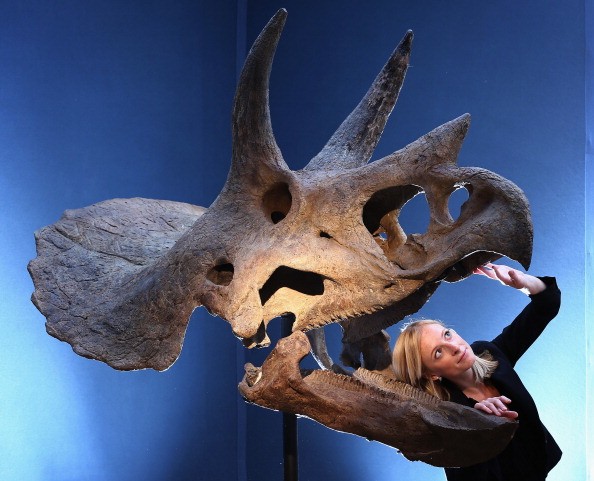Meet Wendiceratops: 3 Facts About This Newly Discovered Horned Dinosaur
| KJ Belonio | | Jul 09, 2015 09:07 PM EDT |
(Photo : Getty Images/Dan Kitwood ) On Wednesday, a newly discovered dinosaur named as Wendiceratops pinhornensis, was unveiled in an report published in the PLOS ONE journal.
On Wednesday, a newly discovered dinosaur named Wendiceratops pinhornensis was unveiled in an report published in the PLOS ONE journal.
According to the new study, the 79-million-year-old bones of four pickup truck-sized horned dinosaurs have been excavated in Alberta, Canada, which is considered as a hotbed of newly discovered ceratopsian dinosaurs. The fossils were discovered in 2011 by renowned fossil hunter Wendy Sloboda.
Like Us on Facebook
Upon seeing the fossils, Cleveland Museum of Natural History head of vertebrae paleontology, curator and study co-author Michael Ryan said they thought they had something new. The experts spent two summers jackhammering the side of the cliff to reach the fossils. Eventually, they saw the bone bed, which included three adults and one juvenile.
In line with the new discovery, here are 3 interesting facts about this ancient horned dinosaur.
1. The name of the new species Wendiceratops pinhornensis is a combination of Sloboda's first name, Wendy, with the Greek word ceratops, which means "horned face." The species name, on the other hand, refers to Pinhorn Provincial Grazing Reserve in Alberta, where the researchers uncovered the fossils, Live Science has learned.
In addition, the researchers have estimated that Wendiceratops pinhornensis measured 20 feet (6 meters) long and weighed more than a ton by examining around 200 bones from the four dinosaurs.
2. Wendiceratops pinhornensis, which looks like its successor Triceratops, was a herbivore and likely grazed on low-lying plants with its parrotlike beak and leaf-shaped teeth. But what intrigued researchers was the dinosaur's skull. As per Time, it has a distinctive, forward-curling frill on top. It has also a frilly neck and horns above its eyes and ears, which paleontologists thought were used in mating rituals.
"The horned dinosaur with the biggest horns may have been able to out-compete its rivals to control the biggest harem for breeding purposes," Ryan told NPR.
3. Toronto's Royal Ontario Museum vertebrae paleontology curator and study co-author David Evans revealed that when the dinosaurs existed, the area where the fossils were found was a lush coastal plain along an interior seaway similar to modern-day Louisiana.
Moreover, the Wendiceratops would have roamed alongside tyrannosaurs, duck-billed hadrosaurs, armoured dinosaurs, turtles and crocodiles. Unfortunately, they likely died and were buried by monsoonal floods, CBC News noted.
Meanwhile, a 3D-printed model of a Wendiceratops skeleton based on the adult bones was unveiled at Toronto's Royal Ontario Museum in January. It was for the launch of the History Channel TV series, "Dino Hunt Canada," which featured footage from the dig.
TagsWendiceratops, Wendiceratops pinhornensis, Wendiceratops discovery, discovery, Facts, Science
©2015 Chinatopix All rights reserved. Do not reproduce without permission
EDITOR'S PICKS
-

Did the Trump administration just announce plans for a trade war with ‘hostile’ China and Russia?
-

US Senate passes Taiwan travel bill slammed by China
-

As Yan Sihong’s family grieves, here are other Chinese students who went missing abroad. Some have never been found
-

Beijing blasts Western critics who ‘smear China’ with the term sharp power
-

China Envoy Seeks to Defuse Tensions With U.S. as a Trade War Brews
-

Singapore's Deputy PM Provides Bitcoin Vote of Confidence Amid China's Blanket Bans
-

China warns investors over risks in overseas virtual currency trading
-

Chinese government most trustworthy: survey
-

Kashima Antlers On Course For Back-To-Back Titles
MOST POPULAR
LATEST NEWS
Zhou Yongkang: China's Former Security Chief Sentenced to Life in Prison

China's former Chief of the Ministry of Public Security, Zhou Yongkang, has been given a life sentence after he was found guilty of abusing his office, bribery and deliberately ... Full Article
TRENDING STORY

China Pork Prices Expected to Stabilize As The Supplies Recover

Elephone P9000 Smartphone is now on Sale on Amazon India

There's a Big Chance Cliffhangers Won't Still Be Resolved When Grey's Anatomy Season 13 Returns

Supreme Court Ruled on Samsung vs Apple Dispute for Patent Infringement

Microsoft Surface Pro 5 Rumors and Release Date: What is the Latest?










